2023年安徽中考英语总复习二轮专题课件:专题二 动词 动词的时态(共27张PPT)
文档属性
| 名称 | 2023年安徽中考英语总复习二轮专题课件:专题二 动词 动词的时态(共27张PPT) |
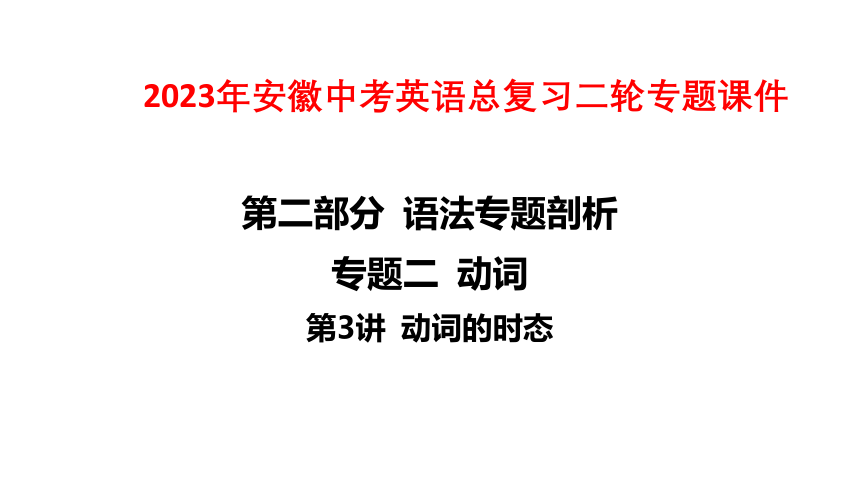
|
|
| 格式 | zip | ||
| 文件大小 | 1.6MB | ||
| 资源类型 | 教案 | ||
| 版本资源 | 通用版 | ||
| 科目 | 英语 | ||
| 更新时间 | 2023-04-06 14:39:40 | ||
图片预览

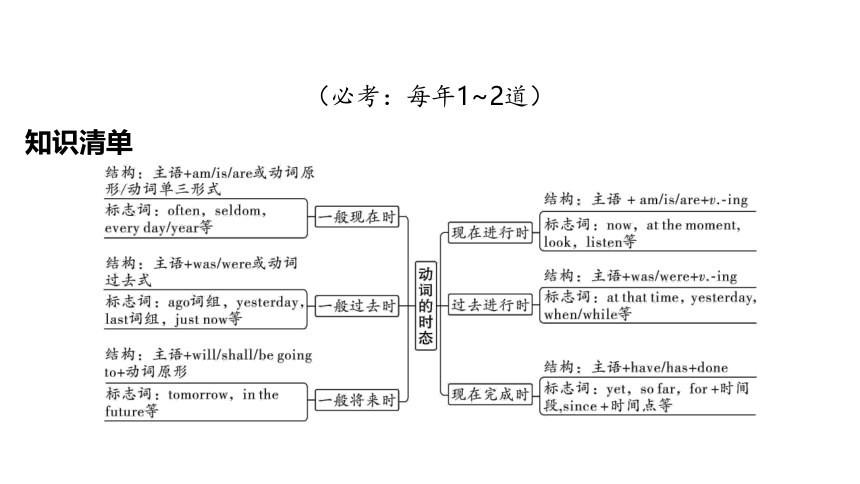
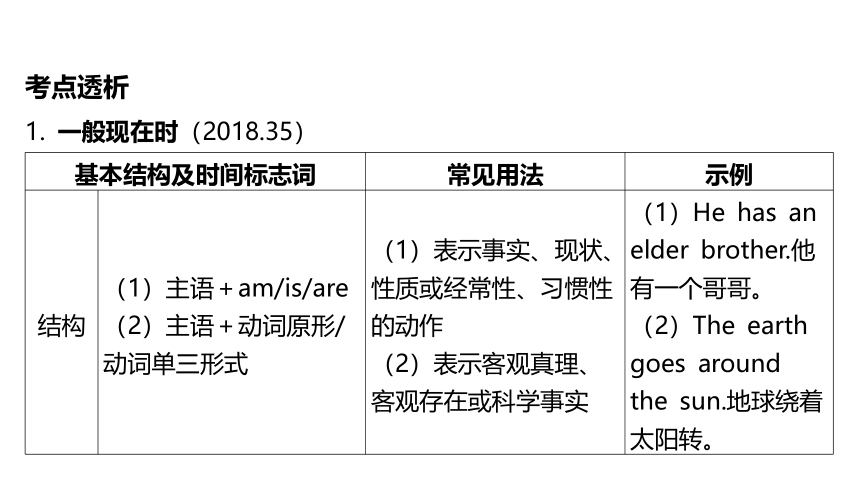
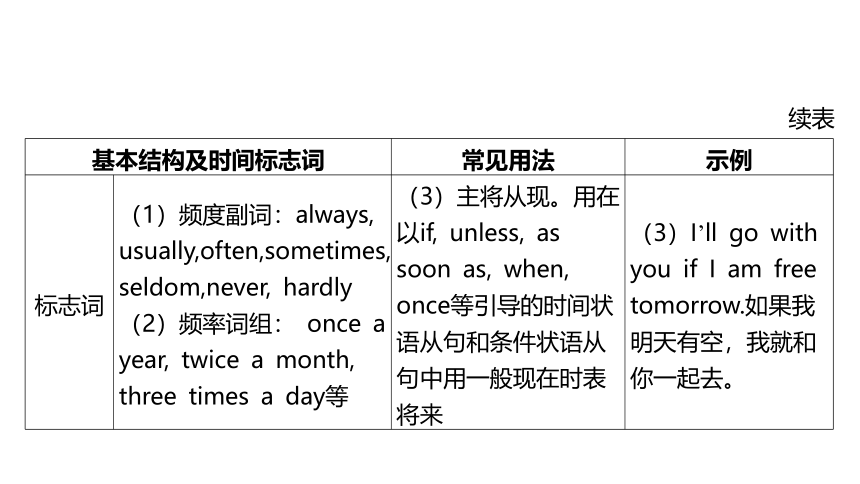
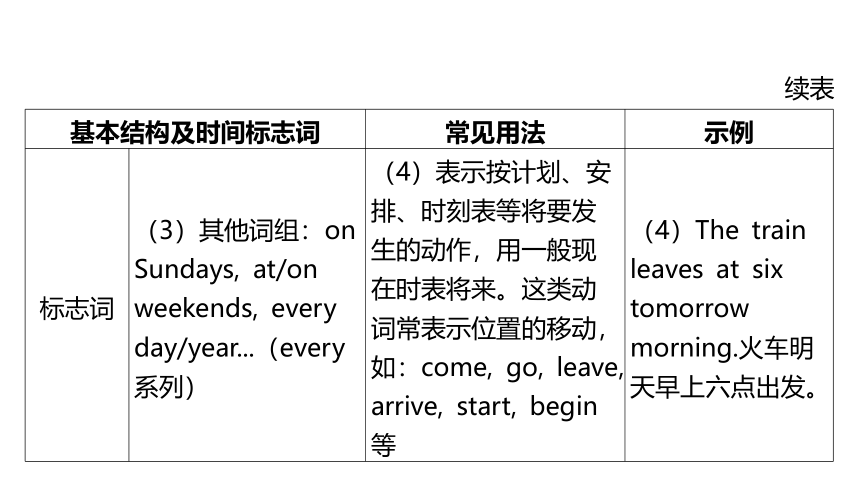
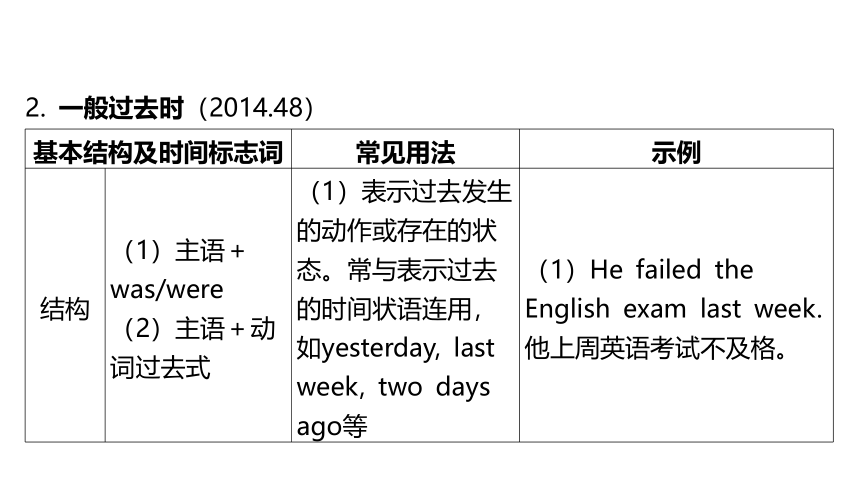

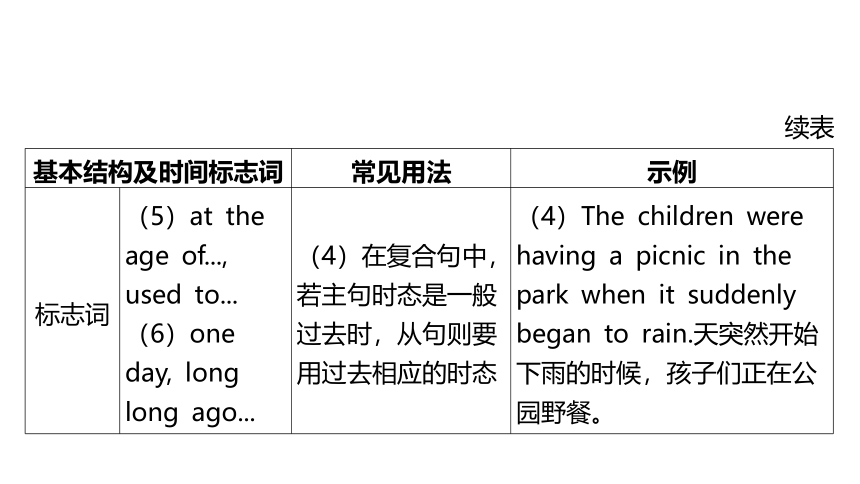
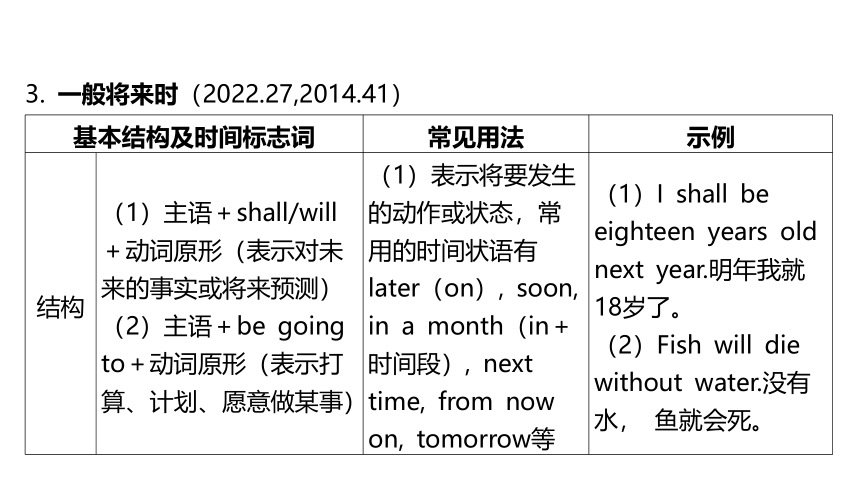
文档简介
(共27张PPT)
第二部分 语法专题剖析
专题二 动词
第3讲 动词的时态
2023年安徽中考英语总复习二轮专题课件
(必考:每年1~2道)
知识清单
考点透析
1. 一般现在时(2018.35)
基本结构及时间标志词 常见用法 示例
结构 (1)主语+am/is/are (2)主语+动词原形/动词单三形式 (1)表示事实、现状、性质或经常性、习惯性的动作 (2)表示客观真理、客观存在或科学事实 (1)He has an elder brother.他有一个哥哥。
(2)The earth goes around the sun.地球绕着太阳转。
基本结构及时间标志词 常见用法 示例
标志词 (1)频度副词:always, usually,often,sometimes, seldom,never, hardly (2)频率词组: once a year, twice a month, three times a day等 (3)主将从现。用在以if, unless, as soon as, when, once等引导的时间状语从句和条件状语从句中用一般现在时表将来 (3)I’ll go with you if I am free tomorrow.如果我明天有空,我就和你一起去。
续表
基本结构及时间标志词 常见用法 示例
标志词 (3)其他词组:on Sundays, at/on weekends, every day/year...(every系列) (4)表示按计划、安排、时刻表等将要发生的动作,用一般现在时表将来。这类动词常表示位置的移动,如:come, go, leave, arrive, start, begin等 (4)The train leaves at six tomorrow morning.火车明天早上六点出发。
续表
2. 一般过去时(2014.48)
基本结构及时间标志词 常见用法 示例
结构 (1)主语+was/were (2)主语+动词过去式 (1)表示过去发生的动作或存在的状态。常与表示过去的时间状语连用,如yesterday, last week, two days ago等 (1)He failed the English exam last week.他上周英语考试不及格。
基本结构及时间标志词 常见用法 示例
标志词 (1)ago及ago词组 (2)yesterday及yesterday词组 (3)last及last词组 (4)just now, in the past, in 1920等 (2)表示过去一段时间内经常性或习惯性的动作。常与always, usually, often 等频度副词连用 (3)since引导的时间状语从句中,从句必须用一般过去时 (2)When I was a little girl, I often played the piano after school.当我还是个小女孩的时候,我放学后经常弹钢琴。
(3)My uncle has worked in the company since he came to Zhengzhou.我叔叔自从到郑州以来一直在这家公司工作。
续表
基本结构及时间标志词 常见用法 示例
标志词 (5)at the age of..., used to... (6)one day, long long ago... (4)在复合句中,若主句时态是一般过去时,从句则要用过去相应的时态 (4)The children were having a picnic in the park when it suddenly began to rain.天突然开始下雨的时候,孩子们正在公园野餐。
续表
3. 一般将来时(2022.27,2014.41)
基本结构及时间标志词 常见用法 示例
结构 (1)主语+shall/will+动词原形(表示对未来的事实或将来预测) (2)主语+be going to+动词原形(表示打算、计划、愿意做某事) (1)表示将要发生的动作或状态,常用的时间状语有later(on), soon, in a month(in+时间段), next time, from now on, tomorrow等 (1)I shall be eighteen years old next year.明年我就18岁了。
(2)Fish will die without water.没有水, 鱼就会死。
基本结构及时间标志词 常见用法 示例
结构 (3)主语+be+动词现在分词[常用于此结构的动词有come, go, leave, arrive, start, begin等(瞬间动词,表示即将发生或安排好要做的事情)] (2)表示某种必然的趋势 (3)“be to+动词原形”和“be about to+动词原形”结构可以表示按照计划将要发生的动作 (3)Jack and Rose are to get married in May.杰克和罗斯将在五月结婚。
(4)Hurry up, or we will miss the bus. 快点儿,否则我们会错过公交车。
续表
基本结构及时间标志词 常见用法 示例
标志词 (1)tomorrow, soon, later (2)next week/month (3)in a week, in 2025 (4)one day, in the (near)future (4)祈使句+and/or+含有将来时的句子 (5)时间、条件等状语从句中主句用一般将来时,从句用一般现在时表将来 (5)The old woman will be happy if her son goes home. 如果老妇人的儿子能回家,她会很开心。
续表
4. 现在进行时(2015.37, 2013.36)
基本结构及时间标志词 常见用法 示例
结构 主语+am/is/are+动词现在分词 (1)表示说话人说话时正在发生的动作或存在的状态 (2)表示长期的或重复性的动作,说话时动作未必正在进行 (1)They are talking with friends.他们正与朋友们谈话。
(2)We are learning to play the piano these days.这些天我们在学习弹钢琴。
基本结构及时间标志词 常见用法 示例
标志词 (1)now, right now (2)at present, at this time, at the/this moment等 (3)已经确定或安排好的将来的活动,常这样用的词主要有come, go, run, leave, begin, arrive等短暂性动词 (3)I’m leaving for a meeting in Shanghai next week.我下周将前往上海开会。
(4)It’s getting warmer and warmer.天气变得越来越暖和了。
续表
基本结构及时间标志词 常见用法 示例
标志词 (3)these days (4)when, while (5)look, listen (4)表示渐变的动作,这类动词有get, grow, become, turn, run, go, begin等 (5)以look, listen开头的句子提示动作正在进行 (5)Listen! She is singing an English song.听!她正在唱一首英文歌。
续表
5. 过去进行时(2016.41)
基本结构及时间标志词 常见用法 示例
结构 主语+was/were+动词现在分词 (1)表示过去某一时间点或某一段时间内正在进行的动作 (1)What was she doing at nine o’clock yesterday morning 她昨天早上九点在干什么?
(2)While he was waiting for the bus, he was reading a newspaper. 他边等车边看报。
(3)I was doing some reading at this time yesterday.昨天这个时候我正在看书。
基本结构及时间标志词 常见用法 示例
标志词 (1)then (2)at that time, yesterday等 (2)含有when或while引导的时间状语从句中,主句用过去进行时,从句用一般过去时或过去进行时,表示动作在过去某一时刻同时进行 (1)What was she doing at nine o’clock yesterday morning 她昨天早上九点在干什么?
(2)While he was waiting for the bus, he was reading a newspaper. 他边等车边看报。
续表
基本结构及时间标志词 常见用法 示例
标志词 (3)when/while引导的表示过去时间的状语从句 (3)常与then, at that time/moment, at this time yesterday连用 (3)I was doing some reading at this time yesterday.昨天这个时候我正在看书。
续表
6. 现在完成时(10年4考)
基本结构及时间标志词 常见用法 示例
结构 主语+have/has+过去分词 (1)表示过去发生的动作对现在造成的影响或结果 (2)表示从过去某一时刻开始一直持续到现在的动作或状态,常与“since +时间点”, “since+从句(一般过去时)”, “for+时间段”及how long, (ever)since, ever, before, so far, in the last/past few years, up to now, till now等时间状语连用 (1)I have finished doing my homework already.我已经写完了我的作业。
基本结构及时间标志词 常见用法 示例
标志词 (1)already, ever, never, just, yet, still (2)recently, lately, so far, up to/till now (3)特殊用法:在现在完成时中,如果有表示时间段的时间状语,则要把非延续性动词变为延续性动词 (2)It has been five years since he joined the army.他已经参军五年了。
续表
基本结构及时间标志词 常见用法 示例
标志词 (3)in the past/last three years/... (4)since 1998, since+时间点 (5)for three years, for+一段时间 (3)I have had the book for two days.这本书我已经买了两天了。(用had而不用bought)
续表
【拓展】现在完成时与一般过去时的区别
两者所表示的动作都发生在过去,但现在完成时强调这一动作对现在造成的影响或结果;一般过去时只表示过去的事实,不表示与现在的关系。如:
I have closed the door.我已经关上门了。(现在门是关着的)
I closed the door just now.我刚才关上门了。(只表示“关门”这个动作)
十年真题
有时间标志词
1.(2020年27题)—The air here is much fresher than before.
—Exactly! We ___ a lot of trees in the past few years.
A.planted B.were planting
C.have planted D.will plant
2.(2016年41题)I saw Sam and David in the playground yesterday
afternoon. They ___ games with their classmates then.
A.play B.will play C.are playing D.were playing
√
√
3.(2014年41题)Mr. Wang has left for Guangzhou. He ___ a
speech there in two days.
A.gives B.gave C.will give D.has given
4.(2014年48题)As we all know, the Silk Road ___ China to the
west in ancient times.
A.connects B.connected C.will connect D.is connecting
√
√
无时间标志词
5.(2022年27题)—What are you saving money for
—Father’s Day is around the corner. I ___ a gift for my father.
A.am going to buy B.have bought
C.bought D.was buying
6.(2021年27题)—Our computer is working again!
—Yes. Our IT teacher ___ it. It took him about an hour.
A.has fixed B.will fix C.is fixing D.was fixing
√
√
7.(2018年35题)Before the sun ___, we need to get to the top of
the mountain.
A.set B.sets C.is setting D.will set
8.(2015年37题)—Cathy, can you answer the door I ___ the
room.
—I’m coming, mum.
A.clean B.cleaned C.have cleaned D.am cleaning
√
√
提升训练
9.Reading books___ a bridge between our lives and the
unknown world.
A.built B.has built C.builds D.will build
10.—Paul, I’m busy cooking. Can you give me a hand?
—Just a minute. I___ my e-mail.
A.am checking B.will check
C.have checked D.was checking
√
√
11.Jenny ___ in the kitchen when you called her at 5 o’clock
this afternoon.
A.is cooking B.was cooking C.cooks D.cooked
√
第二部分 语法专题剖析
专题二 动词
第3讲 动词的时态
2023年安徽中考英语总复习二轮专题课件
(必考:每年1~2道)
知识清单
考点透析
1. 一般现在时(2018.35)
基本结构及时间标志词 常见用法 示例
结构 (1)主语+am/is/are (2)主语+动词原形/动词单三形式 (1)表示事实、现状、性质或经常性、习惯性的动作 (2)表示客观真理、客观存在或科学事实 (1)He has an elder brother.他有一个哥哥。
(2)The earth goes around the sun.地球绕着太阳转。
基本结构及时间标志词 常见用法 示例
标志词 (1)频度副词:always, usually,often,sometimes, seldom,never, hardly (2)频率词组: once a year, twice a month, three times a day等 (3)主将从现。用在以if, unless, as soon as, when, once等引导的时间状语从句和条件状语从句中用一般现在时表将来 (3)I’ll go with you if I am free tomorrow.如果我明天有空,我就和你一起去。
续表
基本结构及时间标志词 常见用法 示例
标志词 (3)其他词组:on Sundays, at/on weekends, every day/year...(every系列) (4)表示按计划、安排、时刻表等将要发生的动作,用一般现在时表将来。这类动词常表示位置的移动,如:come, go, leave, arrive, start, begin等 (4)The train leaves at six tomorrow morning.火车明天早上六点出发。
续表
2. 一般过去时(2014.48)
基本结构及时间标志词 常见用法 示例
结构 (1)主语+was/were (2)主语+动词过去式 (1)表示过去发生的动作或存在的状态。常与表示过去的时间状语连用,如yesterday, last week, two days ago等 (1)He failed the English exam last week.他上周英语考试不及格。
基本结构及时间标志词 常见用法 示例
标志词 (1)ago及ago词组 (2)yesterday及yesterday词组 (3)last及last词组 (4)just now, in the past, in 1920等 (2)表示过去一段时间内经常性或习惯性的动作。常与always, usually, often 等频度副词连用 (3)since引导的时间状语从句中,从句必须用一般过去时 (2)When I was a little girl, I often played the piano after school.当我还是个小女孩的时候,我放学后经常弹钢琴。
(3)My uncle has worked in the company since he came to Zhengzhou.我叔叔自从到郑州以来一直在这家公司工作。
续表
基本结构及时间标志词 常见用法 示例
标志词 (5)at the age of..., used to... (6)one day, long long ago... (4)在复合句中,若主句时态是一般过去时,从句则要用过去相应的时态 (4)The children were having a picnic in the park when it suddenly began to rain.天突然开始下雨的时候,孩子们正在公园野餐。
续表
3. 一般将来时(2022.27,2014.41)
基本结构及时间标志词 常见用法 示例
结构 (1)主语+shall/will+动词原形(表示对未来的事实或将来预测) (2)主语+be going to+动词原形(表示打算、计划、愿意做某事) (1)表示将要发生的动作或状态,常用的时间状语有later(on), soon, in a month(in+时间段), next time, from now on, tomorrow等 (1)I shall be eighteen years old next year.明年我就18岁了。
(2)Fish will die without water.没有水, 鱼就会死。
基本结构及时间标志词 常见用法 示例
结构 (3)主语+be+动词现在分词[常用于此结构的动词有come, go, leave, arrive, start, begin等(瞬间动词,表示即将发生或安排好要做的事情)] (2)表示某种必然的趋势 (3)“be to+动词原形”和“be about to+动词原形”结构可以表示按照计划将要发生的动作 (3)Jack and Rose are to get married in May.杰克和罗斯将在五月结婚。
(4)Hurry up, or we will miss the bus. 快点儿,否则我们会错过公交车。
续表
基本结构及时间标志词 常见用法 示例
标志词 (1)tomorrow, soon, later (2)next week/month (3)in a week, in 2025 (4)one day, in the (near)future (4)祈使句+and/or+含有将来时的句子 (5)时间、条件等状语从句中主句用一般将来时,从句用一般现在时表将来 (5)The old woman will be happy if her son goes home. 如果老妇人的儿子能回家,她会很开心。
续表
4. 现在进行时(2015.37, 2013.36)
基本结构及时间标志词 常见用法 示例
结构 主语+am/is/are+动词现在分词 (1)表示说话人说话时正在发生的动作或存在的状态 (2)表示长期的或重复性的动作,说话时动作未必正在进行 (1)They are talking with friends.他们正与朋友们谈话。
(2)We are learning to play the piano these days.这些天我们在学习弹钢琴。
基本结构及时间标志词 常见用法 示例
标志词 (1)now, right now (2)at present, at this time, at the/this moment等 (3)已经确定或安排好的将来的活动,常这样用的词主要有come, go, run, leave, begin, arrive等短暂性动词 (3)I’m leaving for a meeting in Shanghai next week.我下周将前往上海开会。
(4)It’s getting warmer and warmer.天气变得越来越暖和了。
续表
基本结构及时间标志词 常见用法 示例
标志词 (3)these days (4)when, while (5)look, listen (4)表示渐变的动作,这类动词有get, grow, become, turn, run, go, begin等 (5)以look, listen开头的句子提示动作正在进行 (5)Listen! She is singing an English song.听!她正在唱一首英文歌。
续表
5. 过去进行时(2016.41)
基本结构及时间标志词 常见用法 示例
结构 主语+was/were+动词现在分词 (1)表示过去某一时间点或某一段时间内正在进行的动作 (1)What was she doing at nine o’clock yesterday morning 她昨天早上九点在干什么?
(2)While he was waiting for the bus, he was reading a newspaper. 他边等车边看报。
(3)I was doing some reading at this time yesterday.昨天这个时候我正在看书。
基本结构及时间标志词 常见用法 示例
标志词 (1)then (2)at that time, yesterday等 (2)含有when或while引导的时间状语从句中,主句用过去进行时,从句用一般过去时或过去进行时,表示动作在过去某一时刻同时进行 (1)What was she doing at nine o’clock yesterday morning 她昨天早上九点在干什么?
(2)While he was waiting for the bus, he was reading a newspaper. 他边等车边看报。
续表
基本结构及时间标志词 常见用法 示例
标志词 (3)when/while引导的表示过去时间的状语从句 (3)常与then, at that time/moment, at this time yesterday连用 (3)I was doing some reading at this time yesterday.昨天这个时候我正在看书。
续表
6. 现在完成时(10年4考)
基本结构及时间标志词 常见用法 示例
结构 主语+have/has+过去分词 (1)表示过去发生的动作对现在造成的影响或结果 (2)表示从过去某一时刻开始一直持续到现在的动作或状态,常与“since +时间点”, “since+从句(一般过去时)”, “for+时间段”及how long, (ever)since, ever, before, so far, in the last/past few years, up to now, till now等时间状语连用 (1)I have finished doing my homework already.我已经写完了我的作业。
基本结构及时间标志词 常见用法 示例
标志词 (1)already, ever, never, just, yet, still (2)recently, lately, so far, up to/till now (3)特殊用法:在现在完成时中,如果有表示时间段的时间状语,则要把非延续性动词变为延续性动词 (2)It has been five years since he joined the army.他已经参军五年了。
续表
基本结构及时间标志词 常见用法 示例
标志词 (3)in the past/last three years/... (4)since 1998, since+时间点 (5)for three years, for+一段时间 (3)I have had the book for two days.这本书我已经买了两天了。(用had而不用bought)
续表
【拓展】现在完成时与一般过去时的区别
两者所表示的动作都发生在过去,但现在完成时强调这一动作对现在造成的影响或结果;一般过去时只表示过去的事实,不表示与现在的关系。如:
I have closed the door.我已经关上门了。(现在门是关着的)
I closed the door just now.我刚才关上门了。(只表示“关门”这个动作)
十年真题
有时间标志词
1.(2020年27题)—The air here is much fresher than before.
—Exactly! We ___ a lot of trees in the past few years.
A.planted B.were planting
C.have planted D.will plant
2.(2016年41题)I saw Sam and David in the playground yesterday
afternoon. They ___ games with their classmates then.
A.play B.will play C.are playing D.were playing
√
√
3.(2014年41题)Mr. Wang has left for Guangzhou. He ___ a
speech there in two days.
A.gives B.gave C.will give D.has given
4.(2014年48题)As we all know, the Silk Road ___ China to the
west in ancient times.
A.connects B.connected C.will connect D.is connecting
√
√
无时间标志词
5.(2022年27题)—What are you saving money for
—Father’s Day is around the corner. I ___ a gift for my father.
A.am going to buy B.have bought
C.bought D.was buying
6.(2021年27题)—Our computer is working again!
—Yes. Our IT teacher ___ it. It took him about an hour.
A.has fixed B.will fix C.is fixing D.was fixing
√
√
7.(2018年35题)Before the sun ___, we need to get to the top of
the mountain.
A.set B.sets C.is setting D.will set
8.(2015年37题)—Cathy, can you answer the door I ___ the
room.
—I’m coming, mum.
A.clean B.cleaned C.have cleaned D.am cleaning
√
√
提升训练
9.Reading books___ a bridge between our lives and the
unknown world.
A.built B.has built C.builds D.will build
10.—Paul, I’m busy cooking. Can you give me a hand?
—Just a minute. I___ my e-mail.
A.am checking B.will check
C.have checked D.was checking
√
√
11.Jenny ___ in the kitchen when you called her at 5 o’clock
this afternoon.
A.is cooking B.was cooking C.cooks D.cooked
√
同课章节目录
- 词法
- 名词
- 动词和动词短语
- 动词语态
- 动词时态
- 助动词和情态动词
- 非谓语动词
- 冠词
- 代词
- 数词和量词
- 形容词副词及其比较等级
- 介词和介词短语
- 连词和感叹词
- 构词法
- 相似、相近词比较
- 句法
- 陈述句
- 一般疑问句和否定疑问句
- 特殊疑问句及选择疑问句
- 反意疑问句
- 存在句(There be句型)
- 宾语从句
- 定语从句
- 状语从句
- 主谓一致问题
- 简单句
- 并列句
- 复合句
- 主谓一致
- 主、表语从句
- 名词性从句
- 直接引语和间接引语
- 虚拟语气
- 感叹句
- 强调句
- 倒装句
- 祈使句
- 句子的成分
- 句子的分类
- 题型专区
- 单项选择部分
- 易错题
- 完形填空
- 阅读理解
- 词汇练习
- 听说训练
- 句型转换
- 补全对话
- 短文改错
- 翻译
- 书面表达
- 任务型阅读
- 语法填空
- 其他资料
